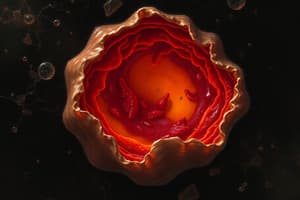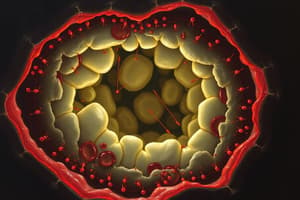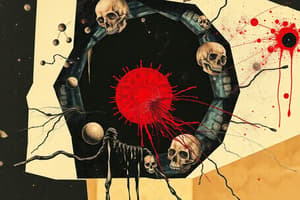Podcast
Questions and Answers
What structural feature is preserved in coagulative necrosis after injury?
What structural feature is preserved in coagulative necrosis after injury?
- Cytoplasmic organelles
- Nuclear structure
- Cell membrane integrity
- Tissue architecture (correct)
What is a characteristic texture of tissues affected by coagulative necrosis?
What is a characteristic texture of tissues affected by coagulative necrosis?
- Firm and dense (correct)
- Crumbly and dry
- Liquid and fluid
- Soft and gelatinous
What primarily limits the proteolysis of dead cells in coagulative necrosis?
What primarily limits the proteolysis of dead cells in coagulative necrosis?
- Recruitment of lymphocytes
- Enzymatic activity increases
- Denaturation of proteins (correct)
- Cellular autophagy
Which process ultimately leads to the digestion of dead cells in coagulative necrosis?
Which process ultimately leads to the digestion of dead cells in coagulative necrosis?
What is the primary cause of coagulative necrosis in solid organs?
What is the primary cause of coagulative necrosis in solid organs?
Which type of necrosis can only be detected microscopically?
Which type of necrosis can only be detected microscopically?
What happens to anucleate cells in coagulative necrosis over time?
What happens to anucleate cells in coagulative necrosis over time?
Which of the following is NOT a feature of coagulative necrosis?
Which of the following is NOT a feature of coagulative necrosis?
What type of cellular injury primarily leads to increased membrane permeability?
What type of cellular injury primarily leads to increased membrane permeability?
Which of the following is NOT a cause of membrane damage?
Which of the following is NOT a cause of membrane damage?
Lysosomal membrane injury results in the leakage of which type of enzymes?
Lysosomal membrane injury results in the leakage of which type of enzymes?
What is a consequence of plasma membrane damage?
What is a consequence of plasma membrane damage?
Which cellular component's injury leads to irreversible damage and necrosis?
Which cellular component's injury leads to irreversible damage and necrosis?
Which of the following proteins is associated with the activation of caspases?
Which of the following proteins is associated with the activation of caspases?
What triggers protein synthesis in response to endoplasmic reticulum stress?
What triggers protein synthesis in response to endoplasmic reticulum stress?
What is a key feature of most types of necrosis?
What is a key feature of most types of necrosis?
What is apoptosis primarily known for?
What is apoptosis primarily known for?
What distinguishes necrosis from apoptosis?
What distinguishes necrosis from apoptosis?
Which of the following occurs first after cell death?
Which of the following occurs first after cell death?
What are the consequences of necrosis?
What are the consequences of necrosis?
What role do leukocytes play in necrosis?
What role do leukocytes play in necrosis?
Under what circumstances does apoptosis occur?
Under what circumstances does apoptosis occur?
What type of stimuli can lead to necrosis?
What type of stimuli can lead to necrosis?
What happens to dead cell fragments during apoptosis?
What happens to dead cell fragments during apoptosis?
How long can skeletal muscle in the leg typically survive complete ischemia?
How long can skeletal muscle in the leg typically survive complete ischemia?
What may signal cell death by apoptosis in a starved cell?
What may signal cell death by apoptosis in a starved cell?
What is one of the primary ways that cell injury occurs?
What is one of the primary ways that cell injury occurs?
What is the role of autophagic vacuoles in infected cells?
What is the role of autophagic vacuoles in infected cells?
Individuals with variants in genes encoding cytochrome P-450 may:
Individuals with variants in genes encoding cytochrome P-450 may:
What is a significant challenge in preventing cell injury?
What is a significant challenge in preventing cell injury?
Which of the following statements is NOT true about cell injury?
Which of the following statements is NOT true about cell injury?
What primarily triggers apoptosis in cells under stress?
What primarily triggers apoptosis in cells under stress?
What is oxidative stress primarily caused by?
What is oxidative stress primarily caused by?
Which of the following statements about reactive oxygen species (ROS) is true?
Which of the following statements about reactive oxygen species (ROS) is true?
What role does the enzyme superoxide dismutase (SOD) play regarding reactive oxygen species?
What role does the enzyme superoxide dismutase (SOD) play regarding reactive oxygen species?
What is the consequence of hydroxyl radicals being produced in the presence of metals like Fe2+?
What is the consequence of hydroxyl radicals being produced in the presence of metals like Fe2+?
What process do phagocytic leukocytes utilize to produce reactive oxygen species during inflammation?
What process do phagocytic leukocytes utilize to produce reactive oxygen species during inflammation?
How does ionizing radiation contribute to the production of reactive oxygen species?
How does ionizing radiation contribute to the production of reactive oxygen species?
In the context of phagocytic cells, what role does hydrogen peroxide (H2O2) play?
In the context of phagocytic cells, what role does hydrogen peroxide (H2O2) play?
What is a consequence of the damage caused by free radicals to cellular components?
What is a consequence of the damage caused by free radicals to cellular components?
Flashcards are hidden until you start studying
Study Notes
Cell Death Mechanisms
- Discovery of regulated cell death highlighted that cell death can be an intentional and controlled process.
- Apoptosis is a type of programmed cell death that eliminates cells with intrinsic abnormalities without triggering inflammation.
- Necrosis represents uncontrolled cell death characterized by cell membrane rupture, leading to enzyme leakage and an inflammatory response.
Apoptosis vs. Necrosis
- Apoptosis occurs in both pathological conditions and healthy tissues, aiding in processes like development and maintaining cellular homeostasis.
- In necrosis, inflammation is induced due to substances released from damaged cells, helping clear debris and initiate repair.
- Necrotic tissue exhibits distinctive morphological patterns, critical for pathology diagnosis, despite not reflecting underlying mechanisms.
Types of Necrosis
- Coagulative necrosis preserves tissue architecture for days post-injury, resulting in firm-textured affected areas.
- Indicative of infarcts caused by ischemia, this type limits proteolysis due to protein denaturation.
- Fibrinoid necrosis can only be identified microscopically, illustrating the importance of detailed examinations.
Cell Injury and Membrane Damage
- Increased membrane permeability leads to necrosis, often due to reactive oxygen species (ROS), nutrient deprivation, or cytoskeletal issues.
- Major sites of membrane damage include:
- Mitochondrial membrane
- Plasma membrane, affecting osmotic balance
- Lysosomal membranes, releasing enzymes that cause irreversible damage.
Autophagy and Ischemic Injury
- Autophagy is a survival mechanism under stress, allowing cells to recycle components when nutrients are scarce.
- Extensive autophagy is noted during ischemic injury and certain myopathies, potentially signaling apoptosis if the cell cannot adapt.
Mechanisms of Cell Injury
- Cell injury can arise from functional and biochemical irregularities in cellular components, leading to apoptosis or necrosis.
- Oxygen and nutrient deprivation (hypoxia and ischemia) primarily disrupt energy-dependent functions.
- Diverse extrinsic causes of cell injury trigger overlapping biochemical pathways, complicating prevention strategies.
Oxidative Stress
- Oxidative stress results from the accumulation of reactive oxygen species (ROS), causing cellular damage.
- Situations contributing to ROS production include chemical exposure, radiation, aging, and inflammation.
- ROS play a critical role in immune responses, particularly in phagocytic leukocytes, enhancing their ability to destroy pathogens.
Role of Reactive Oxygen Species (ROS)
- ROS are chemical species with unpaired electrons, making them highly reactive and unstable.
- They can damage vital cellular components—nucleic acids, proteins, and lipids—leading to cellular dysfunction and death.
- The generation of ROS occurs during inflammation and under stress conditions, particularly in leukocytes through respiratory burst mechanisms.
Studying That Suits You
Use AI to generate personalized quizzes and flashcards to suit your learning preferences.




